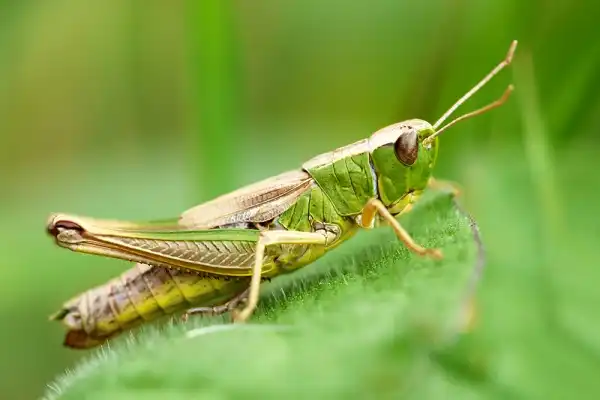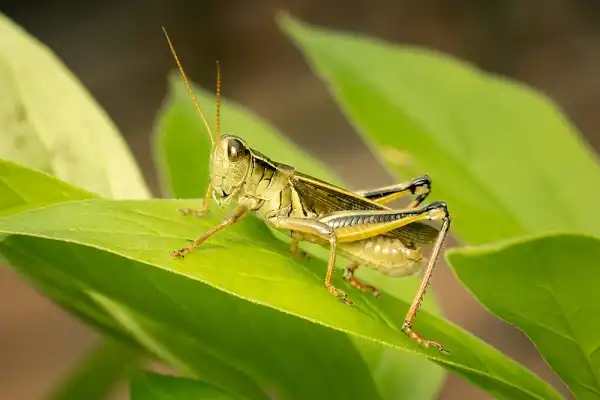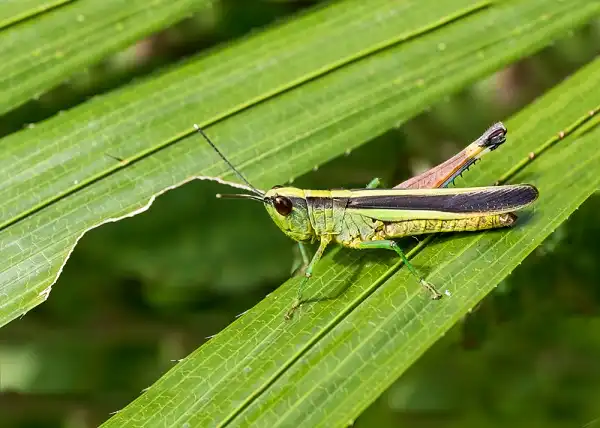For fans of the outdoors, summer is often filled with the sights and sounds of chirping crickets. But have you ever noticed a small green creature with striped legs hopping around your lawn? If so, you may have seen a grasshopper! Grasshoppers are fascinating insects that play an important role in our ecosystems by providing food for birds and other mammals. They can even be kept as pets if given the proper care and attention! This blog post will provide an in-depth look at these interesting creatures—from their diet to their behavior—so read on to learn more about grasshoppers!

Grasshopper Description
Grasshoppers are typically small, winged insects with long antennae and strong hind legs. They come in a variety of colors including green, brown, yellow, and black. One of the most interesting characteristics of grasshoppers is their ability to produce sound. Male grasshoppers rub their wings together to attract females or deter predators by producing a chirping sound known as stridulation. This sound can be heard up to several hundred feet away! Female grasshoppers also produce a clicking noise when disturbed but it is much less intense than the sound made by males.
Grasshopper Habitat
Grasshoppers are found in a variety of habitats, ranging from woodlands and meadows to fields and even gardens. While some species are content to stay in one place for their entire life cycle, others are more adventurous and migrate depending on weather conditions and food availability. Grasshoppers prefer warm, sunny areas with plenty of vegetation and typically avoid cooler, wetter environments. In woodlands and meadows, grasshoppers take shelter in tall grasses or under fallen branches or logs. They may also hide among the leaves of bushes or trees for protection from predators. In fields, grasshoppers often inhabit low-lying vegetation such as clover patches or rest atop weeds or tall grasses. Gardens can provide ideal habitat for certain species of grasshoppers as they offer a variety of plants to feed on as well as an adequate shelter against the elements and predators. Grasshoppers are mainly active during daylight hours but some species may also be seen at night. During the day they spend much of their time searching for food, mating, or resting in shady areas. At night they may return to their shelters to avoid predation by birds and other animals that hunt by sight.
Grasshopper Diet
Grasshoppers have a predominantly herbivorous diet, so their meals consist mostly of leaves and other plant material. They are able to chew these materials into digestible pieces thanks to their specially adapted mouth parts. Grasshoppers will also feed on other insects or small lizards if they can find them, but this is typically less common than eating plants. Grasshoppers are opportunistic feeders, meaning that they take advantage of whatever food sources are available in the environment. In more rural areas with more vegetation and fewer predators, they may wander further away from shelter in search of food. However, in more urban areas where there is less greenery and more predators, they tend to stick to areas close to cover. In addition to vegetation, grasshoppers will also drink water when necessary. They do not need as much hydration as other insects because their bodies have adapted to absorb water from their food as well as from morning dew or moisture in the air.

Grasshopper Size
Grasshopper size varies depending on the species, but they generally range from 2 to 5 cm in length. The larger species can reach up to 10 cm and are usually found in tropical regions of the world. Grasshoppers have two main body parts: the head and thorax, and the abdomen. The front legs of a grasshopper are modified for jumping, and their back legs are used for walking. Grasshoppers have been around since the Triassic period over 200 million years ago, making them one of the oldest insect families still alive today! They are able to survive in almost any kind of environment, with some species being capable of living underwater or even under the desert sand. They can even withstand extreme temperatures ranging from below zero to over 100 degrees Fahrenheit!
Grasshopper Lifespan
The average lifespan of a grasshopper can vary greatly depending on the species and environment. Most wild grasshoppers live for around 2 to 3 months, although some may survive for up to one year in ideal conditions. The temperature, humidity, and access to food all play a role in determining how long an individual grasshopper will live. In captivity, however, some species of grasshopper can live for up to 4 years due to better care and protection from predators. Additionally, their diet can be supplemented with vitamins and minerals that are not available in the wild. This is why pet owners who raise grasshoppers should pay special attention to their nutrition needs! When it comes to reproduction, female grasshoppers will lay eggs at the end of the summer or autumn season and these eggs will remain dormant until springtime when they hatch into small nymphs. These new grasshoppers will go through five stages of instars before they reach adulthood and become capable of reproducing themselves. Overall, the lifespan of a grasshopper is short but significant as they play an essential role in many ecosystems around the world by helping plants propagate and ensuring an adequate balance of nutrients stays in the soil. Their adaptability also allows them to successfully inhabit a wide range of environments which allows them to continue playing this important role for generations!

Grasshopper Behavior
Grasshoppers typically display an omnivorous diet and will feed on both plants and small animals. During the day, they can be seen foraging for food, such as leaves and flowers, or even scavenging for dead insects. At night, some species of grasshoppers can become active hunters, preying on smaller insects like moths or mosquitoes. Grasshoppers also use their large hind legs to jump from place to place in search of food or mates. The larger species of grasshopper are estimated to be able to leap distances up to 20 inches in a single bound! However, most will take shorter hops over shorter distances due to their size restrictions. In terms of social behavior, grasshoppers do not typically form colonies or live in close proximity to one another. They are solitary creatures who prefer to spend most of their time alone and may even show aggressive behavior when disturbed by humans or other animals. Some species do exhibit signs of courtship rituals during mating season which involve singing or producing specific sounds to attract potential mates. Overall, grasshopper behavior is generally well-adapted for survival in their particular ecosystems. They have developed strategies that allow them to find adequate food sources while avoiding predators, using both the environment and their own innate abilities for defense and navigation.
Grasshopper Speed
Grasshoppers are well known for their impressive agility and speed. Depending on the species, one grasshopper can hop up to a maximum speed of 5.6 mph, though most average around 2 mph. This is due to the grasshopper’s powerful hind legs which propel them through the air with great force—like tiny rockets! Additionally, they have large eyes that allow them to detect movement quickly as well as two sets of antennae that help keep track of their surroundings. The amount of speed a grasshopper can reach also depends heavily on its environment. Different terrains such as sand or rocks will affect how fast they can move, as will the presence of wind or moisture. Grasshoppers are also able to sense danger and flee at high speeds when needed, often reaching speeds near 8 mph in order to escape from predators such as birds and reptiles. In addition to their impressive speed, grasshoppers are also capable flyers. Some species use this ability to migrate long distances, while others remain in one area throughout their lifetimes. However, flying places a greater demand on energy resources so most grasshoppers only fly for short periods before returning back to the land where they can more easily find food sources.

Grasshopper Hunting
Grasshopper hunting is a unique activity that showcases their remarkable agility and speed. While they are generally solitary creatures, grasshoppers will join forces when faced with a large predator. When faced with danger, the grasshoppers will flock together and fly in tight formations, making it more difficult for the predator to attack any one individual. This type of cooperative hunting tactic can be seen in other species of insects as well. In addition to this communal behavior, some species of grasshoppers have evolved specialized hunting abilities that allow them to capture larger prey such as small mammals or even birds. These predators usually ambush their victims by concealing themselves within tall grass or foliage and then quickly leaping out to surprise their quarry. Larger species may also use their powerful hind legs to forcibly pin down their prey and consume it alive. These adept hunters also rely heavily on their sense of sight and smell to locate potential meals. By using their antennae, they can detect minute changes in air currents which can indicate the presence of food sources nearby. Their large eyes provide an excellent field of vision which allows them to track movement over long distances and identify vulnerable targets from afar.
Conclusion
Grasshoppers are remarkable creatures that exist in a variety of environments around the world. They have evolved to be incredibly fast and agile, allowing them to escape from predators and find food sources quickly and efficiently. In addition, some species have developed specialized hunting techniques which they rely on to capture larger prey. All of these traits make grasshoppers an important part of any ecosystem as they help keep their populations in balance and provide insight into how nature works.
Frequently Asked Question


